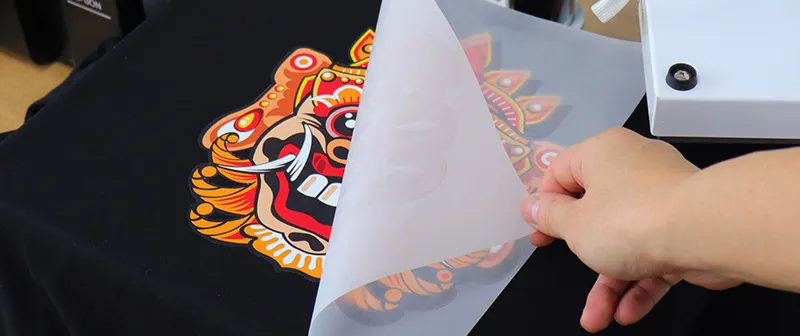Grasping DTF Printing: A Comprehensive Overview to Direct-to-Film Techniques
Wiki Article
Ultimate Overview to DTF Printing Strategies for Sensational Textile Designs
Embarking on the journey of grasping DTF printing techniques can open up a world of opportunities for creating aesthetically exciting fabric designs. In this overview, we will discover the elaborate details of DTF printing, from comprehending the essential basics to unraveling progressed shade strategies that can boost your designs to brand-new elevations.Comprehending DTF Printing Basics
DTF printing, a process that includes moving designs from a special film to textiles using heat and stress, develops the structure of textile printing techniques. The initial step in DTF printing involves producing or selecting a style that will certainly be published onto the textile.As soon as the style is printed on the film, it is after that very carefully put onto the fabric, ensuring proper placement and positioning. The following vital action involves using warm and stress using a warm press maker. This procedure turns on the dyes or pigments on the movie, triggering them to sublimate and bond with the textile fibers completely. The result is a magnificent, durable fabric design that is cleanable, flexible, and immune to fading. In general, understanding the essentials of DTF printing is necessary for understanding this contemporary textile printing method.
Selecting the Right Textile Materials
Having developed the fundamental principles of DTF printing strategies for fabric styles, the next important factor to consider hinges on picking the suitable fabric materials to match this ingenious process successfully. The success of a DTF print mostly depends upon the compatibility in between the selected fabric and the printing method. When picking fabric materials for DTF printing, it is vital to take into consideration the textile's composition, weave, and structure. Fabrics that function well with DTF printing consist of polyester blends, spandex, nylon, and other artificial materials. These fabrics usually have a smooth surface that enables detailed and vibrant prints. In addition, the stretchability of these materials can accommodate the heat transfer procedure associated with DTF printing without distorting the layout. It is a good idea to stay clear of all-natural fibers such as cotton or silk, as they might not yield the very same degree of print clearness and sturdiness. By selecting the appropriate textile products, designers can maximize the possibility of DTF printing to create stunning and lasting textile layouts.
Mastering the Printing Process
To master DTF printing strategies for textile layouts, mastering the printing procedure is crucial for accomplishing top quality and constant results. The printing process in DTF entails numerous essential steps that need accuracy and focus to detail. First of all, preparing the art work for printing is crucial. This consists of making certain the design is properly sized and positioned for the textile. Next, the design is website link printed onto a special DTF film using a compatible printer with the right setups to accomplish ideal color vibrancy and clarity (DTF Printing). Once the design is published, it is after that moved onto the textile making use of a warmth press maker. The temperature level, stress, and period of warm application need to be thoroughly controlled to make sure appropriate bond of the design to the fabric. Furthermore, mastering the peeling procedure after warm pressing is important to stop any damages to the style or material. By developing each of these steps in the printing process, developers can constantly create long lasting and spectacular fabric styles with DTF printing techniques.
Enhancing Styles With Color Methods

Additionally, explore shade slopes can bring a feeling of activity and fluidity to the layout. By blending colors effortlessly, a gradient result can be attained, including a modern-day and vibrant touch to the textile design. Furthermore, using color blocking techniques can produce strong and striking visuals by juxtaposing different solid colors in unique sections of the design.
In addition, incorporating metallic or neon shades can supply a captivating and one-of-a-kind component to the textile style, making it stand apart and radiate a sense of vibrancy. When purposefully applied, these shade techniques can raise the general aesthetic allure of textile layouts, making them a lot more remarkable and fascinating.
Troubleshooting Common DTF Printing Issues
After exploring numerous color strategies to improve textile layouts, official website it is necessary to deal with usual DTF printing problems that might emerge throughout the production procedure. One common problem is inadequate attachment, which can arise from inappropriate treating times or temperature levels. To fix this trouble, make sure that the curing settings are exact and that the sticky used is appropriate for the particular textile being printed on. An additional regular difficulty is shade disparities, where shades may appear in different ways than anticipated. This can be brought on by inaccurate shade accounts or settings in the printing software application. To tackle this, confirm the color settings and accounts to guarantee they match the intended style. Furthermore, concerns with image clearness and intensity can take place due to low-resolution pictures or inappropriate printing strategies. To resolve this, constantly make use of top quality images and change the printing setups for optimum clarity. By being aware of these typical troubles and executing the needed troubleshooting actions, you can boost the total quality of your DTF printed textile styles.Conclusion
In conclusion, grasping DTF printing strategies is necessary for creating spectacular textile layouts. With technique and attention to detail, one can produce gorgeous and distinct textile layouts using DTF printing methods. Styles))))DTF printing, a process that includes transferring styles from an unique movie to textiles utilizing heat and pressure, creates the structure of fabric printing techniques.Having established the fundamental concepts of DTF printing techniques for textile styles, the following essential consideration lies in choosing the proper textile materials to match this ingenious process go to my blog successfully. By choosing the appropriate textile products, designers can optimize the capacity of DTF printing to produce long-lasting and spectacular textile layouts.
To succeed in DTF printing strategies for textile layouts, grasping the printing procedure is vital for achieving consistent and high-grade outcomes. DTF Printing. By refining each of these steps in the printing process, designers can continually generate long lasting and magnificent textile layouts with DTF printing methods
Report this wiki page